EDITOR’S NOTE: The following is a Question and Answer session between The Manitoulin Expositor and Ministry of Transportation. This newspaper’s questions and MTO’s answers follow below.
What are the repairs being done on Swing Bridge?
Mechanical repairs are required to fix one of the wedge assemblies, which is a mechanical part on the Little Current Swing Bridge.
Why were the repairs needed?
On June 28, a mechanical failure occurred on one of the eight wedge assemblies that support the bridge when it is in the closed position to allow highway traffic to cross. There is a degree of flex in the span of the steel bridge when the bridge is in the open position. The wedge assemblies accommodate the flex in the bridge deck by slightly raising the ends of the bridge deck to be flush with the stationary roadway approaches when the bridge is in the closed position.
How long will they take? When will it be completed?
Repairs will take about two weeks to complete.
How much will the repairs cost?
Cost analysis and estimate are currently being developed. There are some variable factors depending on whether the existing wedge assembly can be repaired or a new wedge assembly needs to be fabricated. Some additional testing and analysis of the existing steel that the wedge assembly was made of needs to be completed before final decisions and cost estimates can be determined. The ministry does not expect the cost to repair or fabricate to be significant.
Is this something that has been repaired before? If not this bridge, on another bridge?
The existing wedge assemblies have been in service since the bridge was constructed as a railway bridge over 100 years ago. The wedge assemblies are unique to this bridge, however there may be similar types of mechanical features on other types of moveable bridges in North America.
What impacts will there be to vehicle and marine traffic?
There have been some impacts to marine traffic as a result of this mechanical breakdown. The ministry understands the importance of recreational and commercial marine traffic to the local economy. Bridge operators and a specialized mechanical contractor worked diligently immediately after the breakdown to establish a means to open and close the bridge and manually raise and support the end of the bridge deck where the wedge assembly has broken. A limited opening of three times daily (9 am, 12 pm and 6 pm) was initially developed to immediately provide some access for marine traffic over the Canada Day weekend. In order to provide more balance to marine and highway traffic, the swing schedule will be increased to swing every two hours from 8 am to 8 pm to meet the needs of marine traffic and highway traffic. The new swing schedule started Friday, July 7. Highway traffic may notice some delay during the bridge openings as it does take 5-10 minutes longer to open and close the bridge then under normal conditions.
Is the bridge swinging using manual labour right now?
Yes, the broken mechanical wedge assembly has been replaced temporarily with trained bridge operators to manually jack and shim the end of the deck using hydraulic jacks and steel shim plates to support the deck in the closed position.
Will the repairs require more/less workers to swing it?
While the repairs to the wedge assembly are completed, additional workers will be required to swing the bridge. As normal, one person is required in the control room to engage/disengage the automated swing system. Two additional workers are required to operate the hydraulic jacks and place or remove the steel shim plates for each opening and closure.
How much traffic uses the bridge? When is traffic data from?
The most recent traffic data the ministry has is from 2016. From this data, the average annual daily traffic count is 3,200 vehicles, and the summer average daily traffic count is 4,250 vehicles.



